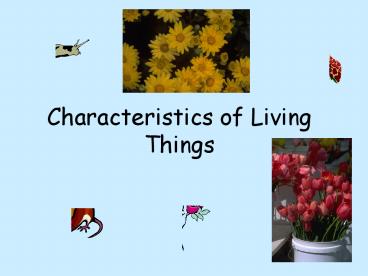Characteristics of Living Things PowerPoint PPT Presentation
1 / 19
Title: Characteristics of Living Things
1
Characteristics of Living Things
2
What is Biology?
1. The study of living things (organisms) 2. The
study of interactions of living things 3.
bio-life ology-study of
3
8 Characteristics of LIFE
Unicellular
- Living Things are made up of Cells.
- a.) CELL Collection of living material
enclosed within a barrier - b.) cells are basic unit of life
- c.) Unicellular made up of one cell
- d.) Multicellular made up of many cells
Multicellular
4
Asexual
2. Living Things Reproduce a.) produce
offspring which resemble parents b.) asexual
reproduction has only one parent c.)
sexual reproduction requires two parents
Sexual
5
3. Living things Grow and Develop a.) GROWTH
increase in size and shape b.) DEVELOPMENT
mature over time c.) living things have a
lifespan
Growth
Development
6
4. Livings things are based on a universal
genetic code A. DNA- determines inherited
traits from parents
7
5. Living things use/need energy a. Energy comes
from food, used to maintain body b.
autotrophs produce their own food c.
heterotrophs must consume food d. decomposers
break down dead material for food
8
6. Living things respond to their surroundings
a.) they react to a stimulus b.) an action
causes a reaction c. ) reaction is
called a response d.) this involves one
individual
9
7. Living things maintain a stable internal
environment A. homeostasis- process by which
organisms maintain a relatively stable internal
environment b.) examples sweating, panting,
shivering, etc
10
8. Living things Evolve a.) adapt to
long-range changes in environment b.) change
to better survive in environment c.) these
changes take place over a long period of time
involving the entire species
11
Characteristics of Living Things
Section 1-3
Characteristic
Examples
Living things are made up of units called cells.
Many microorganisms consist of only a single
cell. Animals and trees are multicellular.
Living things reproduce.
Maple trees reproduce sexually. A hydra can
reproduce asexually by budding.
Living things are based on a universal genetic
code.
Flies produce flies. Dogs produce dogs. Seeds
from maple trees produce maple trees.
Living things grow and develop.
Flies begin life as eggs, then become maggots,
and then become adult flies.
Living things obtain and use materials and energy.
Plants obtain their energy from sunlight.
Animals obtain their energy from the food they
eat.
Leaves and stems of plants grow toward light.
Living things respond to their environment.
Despite changes in the temperature of the
environment, a robin maintains a constant body
temperature.
Living things maintain a stable internal
environment.
Taken as a group, living things change over time.
Plants that live in the desert survive because
they have become adapted to the conditions of the
desert.
Go to Section
12
(No Transcript)
13
Quiz 1 Characteristics of Living Things
14
Quiz 1 The following are all examples of the
characteristics of life. Identify each one.
- Adapt D. genetic code G.
Respond to stimulus - Made of cells E. Grow and develop H.
Homeostasis - Reproduce F. Use/need energy
- You eat a hamburger for lunch.
- A baby gains 3 pounds in one week and begins to
recognize voices. - A polar bear has white fur to blend in with the
snow. - Your start to cry whenever you get a shot at the
doctors office. - You begin to shiver because it is cold outside.
15
Activator 18/16, 8/17List at least 3 things
you think make an organism living.
16
Levels of Organization
Stomach
Muscle cell
Smooth muscle tissue
Digestive system
Have an orderly structure ex cells make up
tissues, tissues make up organs, and organs make
up systems
Go to Section
17
Electrolyte is a "medical/scientific" term for
salts, specifically ions. The term electrolyte
means that this ion is electrically-charged and
moves to either a negative (cathode) or positive
(anode) electrode ions that move to the cathode
(cations) are positively charged ions that move
to the anode (anions) are negatively charged For
example, your body fluids -- blood, plasma,
interstitial fluid (fluid between cells) -- are
like seawater and have a high concentration of
sodium chloride (table salt, or NaCl). The
electrolytes in sodium chloride are sodium ion
(Na) - cation chloride ion (Cl-) - anion As
for your body, the major electrolytes are as
follows sodium (Na)
magnesium(Mg)calcium (Ca2) Potassium
(K) bicarbonate (HCO3-) phosphate (PO42-)
chloride (Cl-) sulfate (SO42-)
18
Electrolytes are important because they are what
your cells (especially nerve, heart, muscle) use
to maintain voltages across their cell membranes
and to carry electrical impulses (nerve impulses,
muscle contractions) across themselves and to
other cells. Your kidneys work to keep the
electrolyte concentrations in your blood constant
despite changes in your body. For example, when
you exercise heavily, you lose electrolytes in
your sweat, particularly sodium and potassium.
These electrolytes must be replaced to keep the
electrolyte concentrations of your body fluids
constant. So, many sports drinks have sodium
chloride or potassium chloride added to them.
They also have sugar and flavorings to provide
your body with extra energy and to make the drink
taste better. Another example where electrolyte
drinks are important is when infants/children
have chronic vomiting or diarrhea, perhaps due to
intestinal flu viruses. When children vomit or
have diarrhea, they lose electrolytes. Again,
these electrolytes and the fluids must be
replaced to prevent dehydration and seizures.
Therefore, drinks such as Pedialyte have sodium
and potassium in them like the sports drinks do.
However, pediatricians do not recommend giving
sports drinks to a sick child! Sports drinks have
much higher sugar concentrations than Pedialyte
and the high sugar is not a proper treatment
19
(No Transcript)

